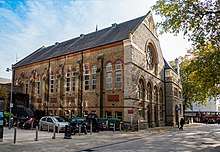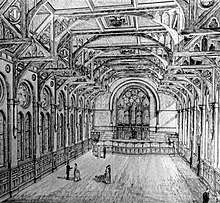Victoria Hall (Ealing)
The Victoria Hall, Ealing is a public hall belonging to the west London community of Ealing for their recreational use. It was conceived in 1886 by Charles Jones the first architect, engineer and surveyor of Ealing Council. Its construction next to Ealing Town Hall was funded entirely by public donations and its operations governed by the Victoria Hall Trust, established in 1893. In 2015 the Council announced plans to sell off the Grade II listed building to a development partner on a long lease.[1] The plan led to protests by local residents' groups who called for the Hall to continue to be available for use as a public asset.[2][3]

History
1800s

The hall's origins and early history are recorded in Jones' 1904 book Ealing: From Village to Corporate Town. He noted that following the start of building a new Town Hall for the Council: "One great desideratum for a growing district like Ealing, viz a public assembly room, was wanting...The happy thought occurred to me that a permanent benefit to the poor might be associated with a Jubilee Hall, and be a perpetual memorial of our beloved Queen."[4]
He put the idea to the Chairman of the Ealing Local Board, Edward Montague Nelson, who agreed "with alacrity". The Middlesex County Times reported at a public meeting at the end of January 1887 that the project was launched to what the paper reported as enthusiastic applause.[5]
Initial funding
It was made clear from the start that no public money was to be involved in the project. While the Town Hall itself was being paid for largely from the sale of the old building, the Memorial Hall, as it was then called, would be paid for by public subscription. An initial sum of nearly £2,000 had already been raised at the time of the public launch, and more subscriptions promised. Mr Montague Nelson, who chaired the 1887 public meeting, said as part of his address: "It is fair to assume that from a hall which is to be built in this way by public subscriptions, on which there is no interest to pay on capital, there will be an income over and above its working expenses [which] should he vested in the existing Local Board, for the time being, as Trustee and devoted by them to local objects…. We might grant a substantial sum annually to, say, the Cottage Hospital and the Almshouses, to the School of Science and Art of which we have one; or a grant to the Free Library." The scheme quickly took off. "Although the whole of the £5,000 for the hall was not obtained at once, a proposal to raise the balance by debentures of £10 each, repayable out of the profits without interest, soon cleared off the remaining debt, and left the memorial hall free as a charitable bequest forever," notes Jones.[6]
Original extent
The original design was for a high main hall at first-floor level with smaller rooms, the Princes Halls at ground and basement level beneath. It allowed for the installation of an organ at the east end with the rose window visible behind, as shown in Jones' own drawing of 1888. As Jones notes this had not been fully achieved by the official opening on 15 December 1888 by Edward, Prince of Wales: "The only regret we have is that the organ, as shown in the original design, was not carried out: £500 still remains at deposit for this object, and some day we may hope to see it accomplished, when Ealing will take its place, as it should have done years ago, as a first-class musical suburb."[7]
Further development
The hall was made available for hire from an early stage for events such as dances, wedding receptions and political rallies.[8]
Victoria Hall became a separate building from the Town Hall after the latter was extended at the northeast corner.[9] The only significant alteration after that date was the infilling of the open 'area' in the basement to the south, which had been a light well to the Princes Hall.[10]
In the 1920s and the 1930s some internal changes were made. The platform inside the Victoria Hall at the west end, which had been accessed from an internal staircase at the southwest, was removed. The external stairs to the second west bay on the north side were also removed, which led to the closure of the access through the bay. At around the same time an external covered way was removed. Public access to the Princes Halls and their related spaces became mainly through stairs below the main internal staircase to the Victoria Hall.[11]
The organ, which had lain unused for some time, was removed and sold to the organ building firm J. W. Walker & Sons Ltd in 1957. The disposal of the organ caused a protracted discussion between Ealing Council and the Charity Commission over the use of the money which was eventually donated to local charities. With the organ no longer in the Hall there was space to simplify the stage, which previously had been on two levels, thereby enlarging the capacity of the hall.[12]
In the 1960s modernisation of the halls took place with false ceiling panels and contemporary lighting. The Princes Hall was converted into a tea room and was used as a staff canteen with access directly onto the street. This development significantly changed the character of the building.[13]
Redevelopment
In July 2016, in the context of large budget deficit and the need to reshape its services,[14] the council announced an agreement with a hotel developer to convert part of the Town Hall and the Victoria Hall into a boutique hotel.[15] Continuing controversy led to an investigation started in 2018 by the Charity Commission to consider whether the Council has the right to sell the Trust's assets.[16][17] On 27 November 2019, the Charity Commission published a draft 'Scheme' that would allow the council to sell off the Victoria Hall, which is held by a charitable trust, to a developer. The scheme prompted criticism from campaigners and concern about the limited amount of time available in a consultation period that would run over the Christmas period.[18]
 1893 Declaration of Trust
1893 Declaration of Trust Commemorative plaque for the 1888 opening of the Victoria Hall
Commemorative plaque for the 1888 opening of the Victoria Hall Ealing Town Hall & Victoria Hall circa 1930 showing the separate entrance (left) to the Victoria Hall
Ealing Town Hall & Victoria Hall circa 1930 showing the separate entrance (left) to the Victoria Hall
References
- "All Change at The Town Hall". EalingToday.co.uk. London. 20 November 2015. Retrieved 17 September 2019.
- "Gloves Off in Battle For Ealing Town Hall". EalingToday.co.uk. London. 13 June 2018. Retrieved 17 September 2019.
- Save the Victoria Hall. Exposurebox.com. London. 17 December 2019. Retrieved 17 December 2019.
- Jones, Charles (1904), Ealing: From Village to Corporate Town, Spaul, p. 42
- "Her Majesty's Jubilee: Meeting in Ealing". Middlesex County Gazette. 29 January 1887. p. 3.
- Jones, Charles (1904), Ealing: From Village to Corporate Town, Spaul, p. 43
- Jones, Charles (1904), Ealing: From Village to Corporate Town, Spaul, p. 43
- "Victoria Hall, Ealing Town Hall consultation". London Borough of Ealing. 9 February 2018. Retrieved 30 April 2020.
- Ordnance Survey map of 1918
- Ordnance Survey map of 1934
- Ealing Borough Surveyor's 1934 Plan
- "London's Town Halls". Historic England. p. 50. Retrieved 25 April 2020.
- "Ealing Town Centre Conservation Area Character Appraisal" (PDF). London Borough of Ealing. 1 December 2007. p. 11. Retrieved 30 April 2020.
- "Ealing Council begins to reshape services as it warns of difficult decisions ahead". EalingNewsExtra.co.uk. Ealing Council. 4 December 2018. Archived from the original on 5 March 2019. Retrieved 30 April 2020.
- "Council Accused of 'Selling Ealing's Crown Jewels'". EalingToday.co.uk. London. 12 July 2016. Retrieved 17 September 2019.
- "Ealing Councillor Lodges Formal Complaint Over Town Hall Hotel Plans". EalingToday.co.uk. London. 13 June 2018. Retrieved 17 September 2019.
- "Further Delays For Ealing Town Hall Sale". EalingToday.co.uk. London. 3 June 2019. Retrieved 17 September 2019.
- "Fears For Future Of Ealing's Historic Victoria Hall". EalingToday.co.uk. London. 2 December 2019. Retrieved 2 December 2019.